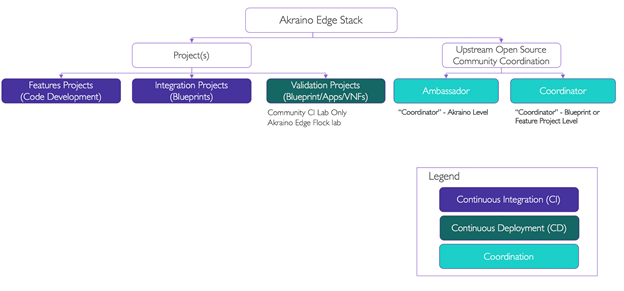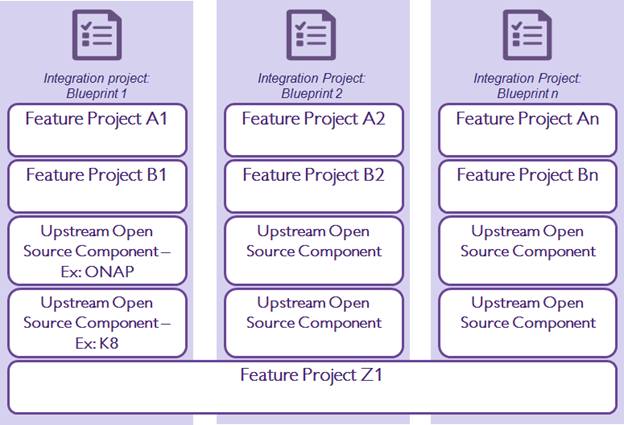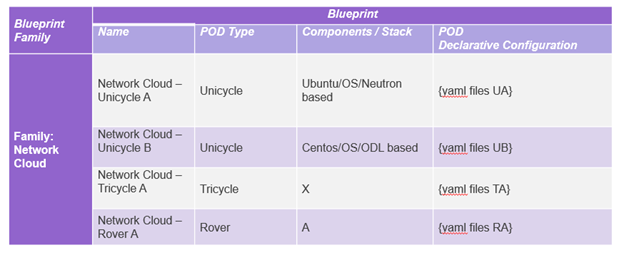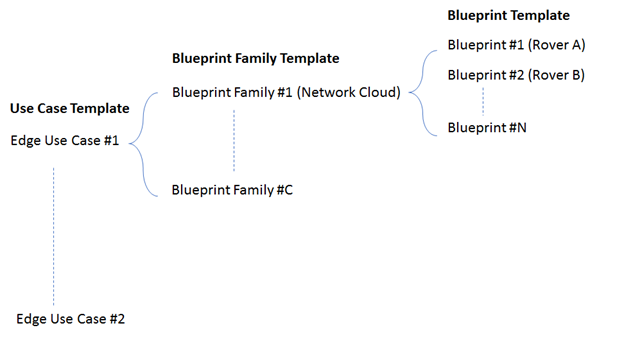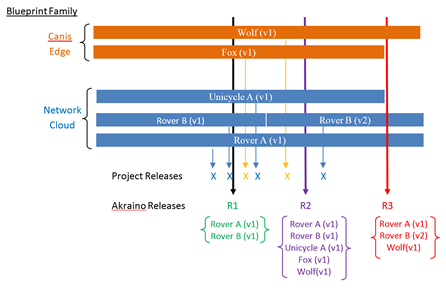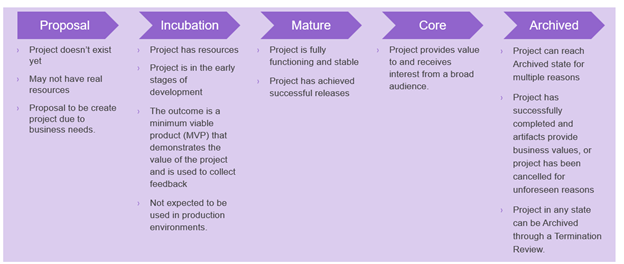| Table of Contents |
|---|
Introduction
The Akraino Edge Stack technical project has been established as Akraino Project a Series of LF Projects, LLC (“Akraino Edge Stack” or, alternatively, the “Project”). LF Projects, LLC is a Delaware series limited liability company. Governance for the Project is detailed within the Project Technical Charter available at akraino.org (“Technical Charter”). This Technical Community Document is intended to provide additional operational guidelines for the Project, and is subject to the Technical Charter. “Akraino” is the term used in this document that refers to ”Akraino Edge Stack” (full form).
1 Guiding Principles
The Akraino Edge Stack Project a Series of LF Projects, LLC (“Akraino”) will operate transparently, openly, collaboratively, and ethically. Project proposals, timelines, and status must not merely be open, but also easily visible to outsiders.
...
The Technical Community consists of multiple projects and a Technical Steering Committee that spans across all projects.
2.1 Technical Mission of Akraino
...
The Akraino Edge Stack Technical mission to focus on following areas
...
In order to have focused work in support of initial releases, the Akraino community preference is to support Edge Blueprints related to enterprise and industrial IoT, and carrier edge network use cases. Board has the authority to define, modify, prioritize any additional industry sectors that need to be supported by the Akraino Edge Stack releases.
The Edge cloud stack placement could vary between Telco Offices to Customer premise and anything in between. Akraino Edge Stack community blueprints should be capable to deploy and address different edge cloud placement options.
...
This document covers the Akraino project lifecycle. The Release Lifecycle will be documented in the wiki.
3.3.2 Akraino
...
Project Types
Akraino will support three categories of projects and upstream coordination activities related to the projects as shown in Figure 3 and further illustration are available under the section 3.3.2.1, 3.3.2.2 and 3.3.2.3 of this document.
The Akraino Edge Stack Community goal is to deliver fully integrated and production deployable solution for the users. The combination of Feature projects (developing missing edge functionalities on non-upstream open source components), Integration projects (integrated end to end stack) and End To End (ETE) validation projects of the blueprints along with edge applications running on top of it, delivers the production deployable solution needed by the industry.
Akraino community uses upstream-first principle to avoid technical debt on the upstream open source components: Akraino projects should not carry patches against upstream projects, but collaborate with and contribute designs and patches to the respective upstream projects to address gaps. Exceptions must be approved by the TSC.
Figure 3 – Akraino Edge Stack Project Types & Scope
3.3.2.1 Akraino
...
Feature Projects (a.k.a Development Project)
The Akraino Edge Stack Feature projects develop edge features, functionalities, interfaces and modules required by an Akraino blueprint or multiple Akraino blueprints to satisfy the Edge use cases and requirements. Feature projects focus on the development work required by Akraino community instead of upstream open source components.
...
The feature project should address the functionality needed by Akraino specified use cases. During the feature project creation the scope should define whether it will support a single or multiple blueprints. Illustration is shown on Figure 4.
Figure 4 – Relationship between Feature Project, Upstream component and Integration project
3.3.2.2 Akraino
...
Integration Projects (Blueprints)
Akraino Integration Projects create or modify Akraino Blueprints to support specific edge use cases.
...
- Each initial blueprint is encouraged to take on at least two Committers from different companies
- Complete all templates outlined in this document
- A lab with exact configuration required by the blueprint to connect with Akraino CI and demonstrate CD. User should demonstrate either an existing lab or the funding and commitment to build the needed configuration.
- Blueprint is aligned with the Akriano Akraino Edge Stack Charter
- Blueprint code that will be developed and used with Akraino repository should use only Open Source software components either from upstream or Akriano Akraino projects.
- For new blueprints submission, the submitter should review existing blueprints and ensure it is not a duplicate blueprint and explain how the submission differs . The functional fit of an existing blueprint for a use case does not prevent an additional blueprint being submitted.
...
Figure 5 – Akraino Blueprint Creation Process
3.3.2.2.1 Akraino Blueprint Family and Life Cycle of Blueprints
At the Family level, blueprints are differentiated by high level technical attributes which are immutable. Removing or inserting one of these attributes would change any pod delivered by the blueprint to such an extent that it could not reasonably be considered part of the same blueprint family.
...
Below picture illustrates the Network Cloud blueprint family and POD level specification which allows possibility of different component level.
Figure 6 - Illustration of blueprint family and its blueprints
3.3.2.2.2 Akraino Use Cases, blueprint families and blueprints
Akraino use cases are business driven and must include a clear description of business requirements, operational considerations (cost, user interface, scale, power restrictions, etc…) , and applications expected to operate on the Blueprint. Any community member can submit a use case for review by TSC for further development.
...
Blueprint templates are required to create or modify blueprints within a blueprint family. In some cases, new or modification to a blueprint may require updates to existing use case templates and/or blueprint family templates and the submitter should make changes to all 3 templates as required.
Figure 7 - Templates needed for blueprint family and blueprint creation and modification
...
Below are the sample templates of a target family of blueprints and the full template will be maintained on the wiki. Certain attributes shall be defined as informational only. For example cost targets whilst key should not be used to pass or fail the verification of a blueprint
3.3.2.2.2.1 Template 1 - Use case template
Below is a sample Use case template. The full template will be maintained on the Akraino Wiki.
Use Case Attributes | Description | Informational | |
Type | New or Modification to an existing submission | ||
Industry Sector | Telco and carrier networks |
| |
Business driver | Emerging technologies such as 5G (vRAN, Core) and associated Edge Services Edge Services requires Cloud instance deployed at the edge of the provider network to network to support latency need.
Without Edge Cloud, above said services cannot be enabled. | ||
Business use cases | For Example:
|
| |
Business Cost - Initial Build | For Example:
| ||
Business Cost - Operational | For Example:
|
| |
Operational need | For Example: Edge Solution should have role based access controls, Single Pane of Glass control, administrative and User Based GUIs to manage all network cloud family based blueprints. The automation should also support zero touch provisioning and management tools to keep operational cost lower |
| |
Security need | For Example: The solution should have granular access control and should support periodic scanning |
| |
Regulations | For Example: The Edge cloud solution should meet all the industry regulations of data privacy, telco standards (NEBS), etc., | ||
Other restrictions | Consider the power restrictions of specific location in the design (example - Customer premise) | ||
Additional details | The Edge Cloud Solution should be deployable across the globe and should be able to support more than 10,000 locations |
3.3.2.2.2.2 Template 2 - Blueprint family template
Below is a sample Blueprint family template. The full template will be maintained on the Akraino Wiki.
Use Case Attributes | Description | Informational | |
Type | New or Modification to an existing submission | ||
Blueprint Family - Proposed Name | Network Cloud Family |
| |
Use Case | Network Cloud |
| |
Blueprint proposed | Central Office deployments
Customer Premise deployments
| ||
Initial POD Cost (capex) | Examples Only:
| ||
Scale | Examples Only:
|
| |
ApplicationsApplications | Any type of Edge Virtual Network Functions |
| |
Power Restrictions | Example Only:
| ||
Preferred Infrastructure orchestration | OpenStack - VM orchestration Docker/K8 - Container Orchestration OS - Linux VNF Orchestration - ONAP Under Cloud Orchestration - Airship | ||
Additional Details | Submitter to provide additional use case details |
3.3.2.2.2.3 Template 3 - Blueprint species template
Below is a sample Blueprint template defining an Akriano Akraino species. The full template will be maintained on the Akraino Wiki.
Use Case Attributes | Description | Informational | |
Type | New or Modification to an existing submission |
| |
Blueprint Family - Proposed Name | Network Cloud Family | ||
Use Case | Network Cloud |
| |
Blueprint proposed Name | Unicycle A |
| |
Initial POD Cost (capex) | Examples Only:
|
| |
Scale & Type |
| ||
Applications | 5G Core or vRAN (RIC) | ||
Power Restrictions | Example Only:
| ||
Infrastructure orchestration | OpenStack Pike or above - VM orchestration Docker 1.13.1 or above / K8 1.10.2 or above- Container Orchestration OS - Ubuntu 16.x VNF Orchestration - ONAP Beijing Under Cloud Orchestration - Airship v1.0 | ||
SDN | SR-IOV & OVS-DPDK or VPP-DPDK |
| |
Workload Type | VMs and Containers | ||
Additional Details | Submitter to provide additional use case details |
3.3.2.3 Akraino Validation Projects
Multiple labs will be used to validate Akraino projects to ensure production quality of blueprint and/or feature project releases. The Community CI lab is owned by the Akraino community and LF. In addition a number of Edge FLock Validation labs are owned by an Akraino community company, organization or participant.
Comprehensive validation of the blueprint within the community will include testing of the OS layer, the undercloud layer, the upper cloud layer, VNF layer and the application layer. Test results should be available to the Akraino Edge Stack community for review via automated push to the wiki. Any defects identified should be logged in JIRA and assigned to the responsible party. When defects are identified in upstream components, Akraino coordinators should be assigned defect ownership. Akraino coordinators will work with upstream communities to resolve defects. For defects that do not involve upstream communities, impacted Protect Technical Leaders should be assigned defect ownership.
...
An automation framework should be used for test procedures and leverage existing test automation suites for upstream projects as required. It is the responsibility of the blueprint submitter to ensure that the Edge Flock Validation and Community CI labs can support comprehensive validation of the blueprint and cover all use case characteristics.
The TSC subcommittees tasked with the setup and structuring of operating procedures for the validation labs shall work to define the licensing requirements for the external labs.
3.3.2.3.1 Feature project unit testing in Community CI lab
The Akraino Community CI labs are owned by the Akraino community and LF. Access is controlled by LF best practices.
...
A full CD that works with the Akraino CI pipeline should be included in the validation project.
3.2.2.3.2 Blueprint and application testing in Akraino Edge
...
Validation lab
Akraino Edge flock Validation labs are owned by an Akraino community company, organization or participant.
The Flock Validation labs can be owned and operated by the supplier of the lab with limited access or no access to the hardware but results of the validation testing need to be shared to the community.
TSC will propose a subcommittee to maintain and coordinate the Flock Validation labs.
Blueprint, application and VNF testing may be performed over a number of Flocks Validations labs concurrently in a coordinated manner as required.
- The Flock Validation labs should be able to connect to Akriano Akraino Edge Stack CI hosted by LF to pull in Akraino blueprints for the validation. Necessary Firewalls can be opened by the Akriano Akraino Community on request.
- All Flock Validation labs should be available most of the year for the community use and if the lab is not used for validation more than 3 consecutive months then it will be removed from the community list.
- Hardware and Network configuration used within the Flock Validation labs should be declared and information should be documented in the wiki
- All the Flock Validation labs addition, modifications or removable need to be approved by TSC
- All historic results (minimum of 1 year) of blueprint validation, Applications and VNF testing should be maintained in the wiki.
3.2.2.3.2.1 Blueprint testing
The test plan and associated test cases to validate the blueprint will be published on the Akraino wiki and reviewed by blueprint stakeholders.
- The lab configuration should support functional, performance, security, and other test cases for the blueprint and cover the full stack for the blueprint.
- Any license or support beyond the Community supplied software should be funded, owned and operated by the flock Validation supplier
Open source test tools and vendor tools with appropriate configurations should drive test traffic profiles that mimic in-scope use cases. Akraino coordinators will engage upstream open source communities to get access to upstream community labs for the Akraino blueprint test team. The submitter is responsible to establish access to necessary vendor labs.
3.2.2.3.2.2 Application and VNF testing
Akraino blueprint releases ensure that applications and virtual network functions (VNFs) can on-board and operate effectively on the Akraino solution. Flock Validation labs can be further used for the validation of Edge applications and VNFs.
...
Submission of results to the Akriano Akraino community is optional in case of commercially sensitive applications.
...
Individual blueprint within a blueprint family shall not be tied to the overall Akraino release schedule (e.g. 6 months). An Akraino release can be composed of 1 to N fully verified blueprints or individual feature projects. As such the number of blueprints and contributing projects within a given Akraino release may vary overtime. Figure 8 show this with two blueprint families, Network Cloud and the imaginary Canis Edge and a number of individual blueprint species within each family.
Figure 8 - Project and Akraino release lifecycles
...
Project State | Description |
Proposal | Project doesn’t really exist yet, may not have real resources, but is proposed and is expected to be created due to business needs. |
Incubation | Project has resources, but is recognized to be in the early stages of development. The outcome is a minimum viable product (MVP) that demonstrates the value of the project and is a useful vehicle for collecting feedback, but is not expected to be used in production environments. |
Mature | Project is fully functioning and stable, has achieved successful releases. |
Core | Project provides value to and receives interest from a broad audience. |
Archived | Project can reach Archived state for multiple reasons. Either project has successfully been completed and its artifacts provide business values, or project has been cancelled for unforeseen reasons (no value anymore, technical, etc.). Project in any state can be Archived through a Termination Review. |
Figure 9 – Akraino Project States
...
From State | To State | Review Description |
Null | Proposal | |
Proposal | Incubation | Incubation review |
Incubation | Mature | Maturity review |
Mature | Core | Core review |
Core | Archived | Termination review |
...
- Successful participation in at least two releases: The project demonstrates stable output (code base, documents) within its history of releases in accordance with the release policy.
- Architecture has been reviewed by the Architecture CommitteeCI/CD Sub-Committee, TSC and presented to broader Akraino community
- Project Contributors have provided a validation lab with exact configuration required by the project to connect with Akraino CI and demonstrate CD. The environment should be reviewed and endorsed by the CI/CD Sub-Committee.
- Project is active and contributes to Akraino: The project demonstrates increasing number of commits and/or Project is active and contributes to Akraino: The project demonstrates a stable or increasing number of contributions across recent releases. Contributions are commits which got merged to a repository of an Akraino commits that have been to an Akraino repository project or a related upstream project. Commits Commit examples can for example be patches to update the requirements document of a project, code addition to an Akraino or upstream project repository, new test cases and so forth.
- Mature artifacts produced: The project demonstrates that the artifacts produced by the project are deployable (where applicable) and have been successfully deployed, configured and used by at least two independent end users ( typically, service providers )who have publicly documented their support on the Akraino wiki and within the accompanying project documentation.
3.3.7.3 Core Review
The goal of the Core Review is to ensure:
...
- Introduction
- Release Deliverables
- Release Milestones
- Expected Dependencies on Other Projects
- Compatibility with Previous Release
- Themes and Priorities
- Features delivered
- Non-Code Aspects (user docs, examples, tutorials, articles)
- Architectural Issues (if any)
- Security Issues (if any)
- Quality Assurance (test coverage, etc)
- End-of-life (API/Features EOLed in Release)
- Summary of Outstanding Bugs
- Summary of Standards Compliance
- Delta between planned schedule and actual schedule
- Features delivered
- Non-Code Aspects (user docs, examples, tutorials, articles)
- Architectural Issues (if any)
- Security Issues (if any)
- Quality Assurance (test coverage, etc)
- End-of-life (API/Features EOLed in Release)
- Summary of Outstanding Bugs
- Summary of Standards Compliance
- Delta between planned schedule and actual schedule
3.3.8.2 Release Review
- Features delivered
- Non-Code Aspects (user docs, examples, tutorials, articles)
- Architectural Issues (if any)
- Security Issues (if any)
- Quality Assurance (test coverage, etc)
- End-of-life (API/Features EOLed in Release)
- Summary of Outstanding Bugs
- Summary of Standards Compliance
- Delta between planned schedule and actual schedule
3.4 3.4 Amendments to the Technical Community Document
...
Figure 10 - Akraino Community Structure
4.3 TSC Functional Roles
...
The primary responsibility of the TSC Chair and Co-Chair are to represent the technical community in communications with the LF Akraino Edge Stack Fund of The Linux Foundation and to be responsible for:
...
A coordinator can act as the ambassador to external upstream communities in communicating the requirements need to be addressed in the upstream community on behalf of Akriano Akraino Feature or Blueprint project. TSC can appoint either Akriano Akraino level or project level coordinators to facilitate upstream coordination work. Coordinators can act as a technical liaison only and cannot represent strategy aspects of the Akriano Akraino which will be handled by TSC.
...
Coordinators support the TSC Chair in the execution of TSC responsibilities (Section 4.5) and the delivery of Akraino releases. They are responsible for fostering collaboration among the many parties that need to work together to identify, characterize, and solve problems, they do not direct solutions.
4.3.3.2 Coordinator origin
...
The TSC will solicit nominations for the role. Nominees should have subject matter experience in the relevant coordination area. In the event that multiple candidates self-nominate, the TSC will hold an election as defined in section 4.4.3.3.
...
Coordination Area Termination.
A coordination area can be terminated by sending an email to the TSC via the Akraino-TSC email list. The email shall have the following.
...
There are no limitations on the number of candidates that can run in an election for TSC membership, nor is there a limit to the number of candidates from any organization including its subsidiaries (hereon termed simply an ‘organization’) that can run for TSC membership. However the limits as defined in the TSC technical charter 4.4.3.2.1 section (TSC approved 9/5/19) for the total number of TSC members from a given organization shall be enforced by means of the election and interim election process described in 4.4.3
Candidates must self nominate.
4.4.2.1.1 Candidate and Voter Eligibility
Any Active Contributor community member is eligible to run for TSC membership
...
Candidates must self nominate.
4.4.2.2.1 Candidate and Voter Eligibility
All TSC members are eligible to run for the roles of Chair or Co-Chair.
...
Candidates must self nominate (even if nominated by the TSC).
4.4.2.3.1 Candidate and Voter Eligibility
Any community member (regardless of TSC membership) is eligible to serve as a coordinator. Nominees should have subject matter experience in the relevant coordination area.
...
All TSC Active Contributors may cast a single vote
4.4.3.2.1 Enforcement of organization TSC member limits.
The CIVS election wil rank all standing candidates from 1 to N.
Only one (1) person from any company, or a group of related companies can be elected as a TSC member at any given time. (TSC approved 9/5/19)
If If any organization entered more than the permitted limit of electable candidates all excess candidates shall be removed from the results from the least ranked upwards until the organization limit is reached.
Once this is done the remaining 20 highest ranked candidates shall be elected to the TSC.
4.4.3.2.2 Interim elections
In case a TSC member, including Chair or Co-Chair, steps down or is required to step down due to, no longer able to perform the TSC duties, moved to a different company (TSC approved 9/5/19), organization limits being exceeded or as a result of company acquisitions or mergers after each yearly election, an interim election may be called by the TSC . (TSC approved 9/5/19)
In all above cases, the TSC member may inform via an email to the TSC email list, an interim election may be called by the TSC for that single position within 60 days of the notification from the leaving TSC member. Interim election can be used to reelect the open TSC position. The period of the TSC member elected using the interim election can be up to next full election. (TSC approved 9/5/19)
In an interim election, any organization eligible contributors (TSC approved 9/5/19) may only enter candidates if their current representation on the TSC is below their an organization may only enter candidates if their current representation on the TSC is below their organization’s TSC Member limit.
...
Election of a TSC Chair/Vice Chair/Coordinator shall use a multiple-candidate method shall consist of a single stack ranked vote of all candidates using CIVS https://civs.cs.cornell.edu/
4.
...
Subject to the Technical Charter, the TSC is responsible for:
...
4.3.4 TSC Member Contributions (TSC approved 9/5/19)
Contributions to the Akraino Community may be counted as either ‘individual’ or “individual contribution on behalf of a company”. A ‘individual’ contribution is made by a named individual. An “Individual contribution on behalf of a company” are governed by the policy of an individual’s Organization to whom they were affiliated at the time of the contribution. Individual contributions cannot be transferred to other individual.
For the TSC election purpose, the Organization can request the TSC to count an “individual contribution on behalf of a company” to another named individual of their Organization at any time regardless of whether the original Contributor remains in or has left the Organization. If an individual Contribution leaves an Organization that Organization may at their sole discretion decide to: retain all their Contributions and reallocate them to another named individual within their Organization (for the TSC election purpose). Organization should inform TSC of such details of contributions and reallocation in writing.
OR
agree to transfer all their Contributions to the individual’s new Organization thereby releasing all interest in the previous Contributions to the Individual’s new Organization. Organization should inform TSC of such details of contributions and releasing in writing.
4.5 Responsibilities of the TSC
Subject to the Technical Charter, the TSC is responsible for:
- Defining Akraino’s release vehicles (such as a Coordinated Release) that align with the Project’s mission
- Fostering cross-project collaboration
- Serving as Akraino’s primary technical liaison body with other consortiums and groups
- Developing an architecture
- Setting simultaneous release dates
- Defining release quality standards
- Defining technical best practices and community norms (including the establishment and maintenance of a Development Process)
- Monitoring technical progress
- Mediating technical conflicts between Committers and PTLs
- Organizing inter-project collaboration
- Coordinating technical community engagement with the end-user community
Identifying and Recruiting Akraino Localized Organizations
4.5.1 Identifying and Recruiting Akraino Localized Organizations
The TSC shall be responsible for identifying and recruiting suitable organizations amenable to cooperation in establishing centers providing technical and marketing resources in geographically distinct areas to support Akraino blueprint teams and groups based in those areas. Such "localized" areas are typically characterized by language, time-zone, and international differences, for example the TSC might seek to establish a South America center, an Africa center, a Shenzhen center, etc.
When an organization has been identified, TSC members shall meet to discuss and evaluate the organization to determine its suitability, based on the following technical, marketing, and operational criteria:
- The organization must present a public website with goals and mission statement indicating a non-profit, open, collaborative nature, preferably with .org domain suffix. Examples include foundations, consortiums, development communities, user communities, etc.
- The organization must be a technical organization, with emphasis on open source software and hardware
- The organization must be engaged in sufficient marketing and promotional efforts, including online and social media. The organization must be able to incorporate Akraino web links, material, and blueprint documentation in substantial, appropriate, and prominent manner
- The organization may be associated with academic institutions
- The organization may have sponsor companies
- The organization must demonstrate support, or an acceptable plan of support, for a range of CPU types, including but not limited to x86, Arm, RISC, SoC (e.g. FPGA with CPU cores)
- The organization may provide working area(s), including WiFi or other Internet capable of online video/audio collaboration. Server and other development hardware resources are preferred but not required
- The organization must agree to comply with Policy and Operational Procedures as listed on the Akraino Regional Communities page
During the discussion and evaluation phase, the TSC may at its option nominate and vote to approve an Akraino representative to act as "point person" to work with the candidate organization's senior / authorized management to resolve concerns, negotiate objectives and requirements, gather facts and data, and otherwise act on behalf of the TSC. The point person may be a TSC member, subcommittee chair or co-chair, or other. The point person may recruit others to help with the effort. As one example, the TSC might designate the "Outreach Subcommitee" chair as the point person, who then might recruit helpers from other subcommittees or blueprint projects.
After the discussion and evaluation phase, including updates from the point person if one has been designated, the TSC shall vote to decide whether to formally engage with the candidate organization. Should the vote succeed, the TSC shall present the candidate organization, along with its evaluation results, to Akraino's parent Linux Foundation management for further, formal action
...
.
4.6 TSC Subcommittees
The TSC, at its discretion, may establish subcommittees to assist the TSC with its responsibilities and provide expert guidance in technical subject areas (e.g., architecture or security).
The From time to time, (a) the TSC may amend or introduce alternative approaches to convene and run subcommittees and (b) decide to disband subcommittees that are no longer active or that no longer have any active members.
4.6.1 Membership
4.6.1.1 Subcommittee Membership Eligibility
...
Each subcommittee may elect a Chair and optionally a Co-Chair who is responsible for leading meetings and representing the subcommittee to the TSC.
4.6.1.3 Subcommittee Chair / Co-Chair Elections
The Chair or Co-Chair will be elected by members of the subcommittee as of the date the nomination process starts for the election.
4.6.1
...
.3.1 Subcommittee Interim Elections
In case a subcommittee The Chair or Co-Chair will be elected by members of the subcommittee as of the date the nomination process starts for the electionsteps down or isno longer able to perform subcommittee duties (for example, moved to a different company, no longer active in Akraino, etc), an interim election may be called by the TSC. The term of the subcommittee Chair or Co-Chair elected as a result of the interim election can be up to the next full election.
Interim elections shall otherwise follow all the same procedures and use the same voting schemes as yearly elections.
4.6.1.4 Subcommittee Voter Eligibility
...
As a guideline, a subcommittee is most appropriate when the task to be addressed involves a relatively stable group of people with a high level of intersection of common involvement. A coordinator is more appropriate when there is a more dynamic group of people and issues may change frequently. A coordinator is also more appropriate for smaller efforts or topics requiring infrequent meetings.
Glossary
...
Term | Full Meaning |
IoT | Internet of things |
PTL | Project technical lead |
ETE | End to end |
SDK | Software development kit |
API | Application program interface |
POD | Point of delivery |
CI/CD | Continuous integration and continuous delivery |
LCM | Lifecycle management |
YAML | YAML Ain't Markup Language. It's basically a human-readable structured data format. |
OS | Operating system |
EOL | End of life |
VNF | Virtual Network Function (VM or container based) |
CIVS | Condorcet Internet Voting Service |
...
